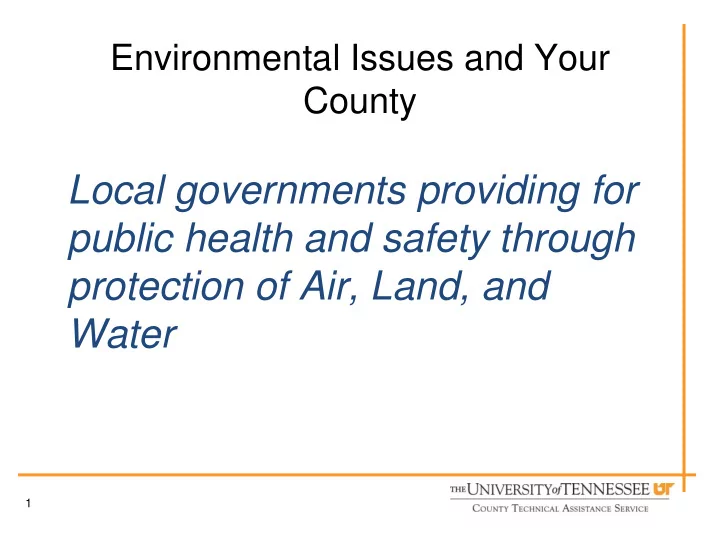

Environmental Issues and Your County Local governments providing for public health and safety through protection of Air, Land, and Water 1
Counties Contend with Host of Environmental Topics Solid Waste/Land Use/Air Quality/Water Quality/Planning/Econmic Development/Tourism 2
Solid Waste Management Act of 1991 • County Responsibilities: – Proper management of solid waste collection, transfer, transport, processing, and disposal • Includes recycling, diversion, waste tire management and problem waste collection. • Solid Waste Region Responsibilities – Must have Solid Waste Plan – Must meet 25% Waste Reduction Goal – Must provide for Community Education 3
Components and Services • Planning • Household • Waste Reduction Hazardous Waste • Financing • Used Oil • State Grants • Education, • Waste Tires Information and • Recycling Reporting • Collection and Transportation 4
Collection,Transportation and Disposal Each county must assure that a collection system is available to all residents. • Type collection system • How transported • Where disposed • How financed 5
Waste Reduction/Recycling • Counties must divert 25% of Waste (T.C.A. 68-211-821) • How waste reduction is measured (T.C.A. 68-211-835) 6
Restrictive Wastes • Whole tires can not be disposed of in Tennessee landfills • Other problem wastes include oil, batteries, and recently “E-wastes”. • Household Hazardous Waste collection events are funded by TDEC and can serve as participatory community events. 7
Financing Solid Waste • Solid Waste • Recycling Rebate (11 Management Fund counties) (T.C.A. 68-211-821) • Recycling Equipment • Material Recovery • Local Funding Options Facility (T.C.A. 68-211-835) • Used Oil • Used Oil Collection • Waste Tire Funding Fund • Development Districts (T.C.A. 68-211-1005) • Household Hazardous Waste • Planning Grants 8
How CTAS can help.. Technical Assistance Areas • Facility Siting and Regulatory Issues • Waste Reduction • Bids and Equipment Specification • Cost Effectiveness 9
Water Issues • Water Quantity • Water Quality • Source Water Protection
FIVE MAJOR RIVER BASINS OF TENNESSEE AND POSSIBLE INTER-BASIN TRANSFERS Cumberland Barren KY Pipeline Mississippi Tennessee Tombigbee Waterway Conasauga Pipeline ? Pipeline ? 11
12
Point Source Pollutants . . . are identifiable sources of pollution such as a pipe or ditch from a municipal or industrial wastewater treatment facility. 13
Nonpoint Sources of Pollution . . . created when rain, snow or irrigation runoff flows over or through the ground and picks up pollutants
Storm Water Discharges, Phase I • Phase I of this federal program was implemented in 1990. • Phase I used a permit system to regulate storm water discharges from larger cities and construction projects.
Storm Water, Phase II? • Expanded Phase I by requiring counties, cities, and additional other parties to implement programs and practices to control stormwater runoff. • If you are named, you need a Permit and plan
Counties often need to address Surface Runoff Problems • New Development can increase likelihood of flooding • Bare soils and “impervious surfaces” contribute to runoff • Can lead to “impaired stream” designation and permit violations
Applies to everyone in Tennessee • Must notify the Division of Water Pollution Control to receive a permit for grubbing, clearing, grading or excavation of 1 or more acres of land • Could be in the form of a StormWater Pollution Prevention Plan (SWPPP)
Phase II Funding/Financing • Debt Financing-for capital-intensive projects • Federal, State, or Regional Grants and Loans (ex. State Revolving Loan Fund—SRF) • Stormwater Utilities • General Fund • Plan Review and Inspection Fees • Fee-in-Lieu of On-Site Construction
Air Quality Issues •EPA recently revised the standard for two ‘criteria pollutants’, OZONE and PARTICULATE MATTER. •These revisions impact Tennessee government, business and residents.
Southeastern areas exceeding the 8-hour ozone standard About 65% of Tennesseans live in non- attainment counties 494 counties named, nationwide Source: www.epa.gov 21
What does “non-attainment” mean? • The ‘Measured levels’ for these criteria pollutants have exceeded the health- based standard Or…The air is not always healthy to breathe
How can non-attainment affect my county? • Possible Impact on economic development • Tougher permitting for industry • Industrial recruitment difficult • Highway funds subject to transportation conformity rules
Final Comments.. •Recognize and promote your existing county programs • Take proactive stance on regulatory issues •Strive for most efficient and affordable ‘service delivery’ that assures public health and safety •Call CTAS 24
Recommend
More recommend